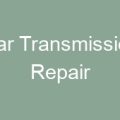Car Repair Tutorials

Car Repair Tutorials: Clear, concise guides to fix your car. No jargon, just direct instructions. Learn how to repair your vehicle hassle-free.
Looking for comprehensive car repair tutorials to learn how to fix your vehicle? Look no further. Our website offers an extensive collection of DIY car repair tutorials that cover a wide range of common issues. Whether you are dealing with engine problems, brake repairs, or electrical issues, our step-by-step guides will walk you through the process. With our car repair tutorials, you can save money on expensive mechanic fees and gain the satisfaction of fixing your own car. Our easy-to-follow instructions and detailed illustrations make it simple for anyone to become a car repair expert. Start learning today and become your own car repair guru.
| Car Repair Tutorials: Learn how to fix common car issues. |
| Changing Tires: Step-by-step guide to replace a flat tire. |
| Oil Change: Properly maintain your engine by learning to change oil. |
| Battery Replacement: Easily replace a dead car battery with our tutorial. |
| Brake Pad Replacement: Learn how to change worn brake pads on your car. |
- Spark Plug Replacement: Keep your engine running smoothly by replacing spark plugs.
- Air Filter Replacement: Improve air quality and performance by installing a new air filter.
- Headlight Bulb Replacement: Illuminate the road ahead by changing a burnt-out headlight bulb.
- Windshield Wiper Replacement: Ensure clear visibility in rainy weather with new wiper blades.
- Engine Coolant Flush: Prevent overheating and maintain engine performance with a coolant flush.
How do I change the oil in my car?
To change the oil in your car, begin by gathering the necessary supplies, such as a wrench, oil filter, and new oil. Locate the oil drain plug underneath the car and place a container beneath it to catch the old oil. Unscrew the drain plug using the wrench, allowing the old oil to drain completely. Remove the old oil filter and replace it with a new one, making sure to lubricate the rubber gasket on the new filter. Screw the drain plug back in and refill the engine with the recommended amount of new oil. Finally, start the car and check for any leaks.
What are the signs of a faulty alternator?
If your car’s alternator is faulty, you may experience several warning signs. These can include dim or flickering headlights, a battery warning light on the dashboard, difficulty starting the car, and a dead battery. Additionally, you may notice unusual smells, such as a burning odor, or hear strange noises coming from the alternator. If you suspect a faulty alternator, it is important to have it inspected and repaired by a professional mechanic to prevent further damage to your vehicle.
How can I replace a flat tire?
To replace a flat tire, first, ensure your car is parked on a flat surface and engage the parking brake. Locate the spare tire, jack, and lug wrench in your vehicle’s trunk. Loosen the lug nuts on the flat tire using the lug wrench, but do not remove them completely. Position the jack under the car’s designated lifting point and raise the vehicle until the flat tire is off the ground. Remove the lug nuts and the flat tire, then mount the spare tire onto the wheel studs. Tighten the lug nuts by hand, lower the car back down, and fully tighten the lug nuts with the lug wrench.
How do I check and replace my car’s brake pads?
To check your car’s brake pads, remove the wheel and visually inspect the brake caliper. Look for signs of wear on the brake pads, such as thinning or unevenness. If the brake pads appear worn, it is necessary to replace them. To replace the brake pads, remove the caliper bolts and slide out the old pads. Use a C-clamp to compress the caliper piston, then insert the new pads and secure them with the caliper bolts. Remember to pump the brake pedal several times after replacing the pads to ensure proper braking performance.
What causes my car’s engine to overheat?
Several factors can cause a car’s engine to overheat, including a malfunctioning thermostat, low coolant levels, a faulty radiator fan, or a broken water pump. If your engine temperature gauge is in the red or you notice steam coming from the hood, it is important to address the issue immediately. Safely pull over and turn off the engine to prevent further damage. Check the coolant level and ensure the radiator fan is functioning properly. If the problem persists, consult a mechanic for further diagnosis and repairs.
How can I jump-start my car’s battery?
To jump-start your car’s battery, you will need a set of jumper cables and a functioning vehicle. Park the assisting vehicle close to your car, making sure the engines are not touching. Connect one end of the positive (red) jumper cable to the positive terminal of the dead battery and the other end to the positive terminal of the assisting vehicle’s battery. Connect one end of the negative (black) jumper cable to the negative terminal of the assisting vehicle’s battery and the other end to a grounded metal surface on your car, such as a bolt. Start the assisting vehicle and let it run for a few minutes, then try starting your car. Once your car is running, remove the jumper cables in the reverse order.
What should I do if my car is leaking fluids?
If your car is leaking fluids, it is crucial to identify the source and take appropriate action. Park your car in a safe location and inspect the color and consistency of the leaking fluid. Coolant is typically green, pink, or orange, while oil is brown or black. Transmission fluid is red, and brake fluid is clear or yellowish. If the leak is significant or you are unsure of the fluid type, it is best to consult a professional mechanic. Continuing to drive with a fluid leak can lead to severe damage and potentially unsafe driving conditions.
How do I replace a broken car window?
To replace a broken car window, begin by wearing protective gloves and eyewear. Remove any remaining glass fragments from the window frame using a vacuum or tape. Measure the dimensions of the window opening and order a replacement glass panel. Apply adhesive to the window frame and carefully insert the new glass panel. Press firmly to ensure proper adhesion and use tape to hold the glass in place while the adhesive dries. Clean the window thoroughly to remove any adhesive residue. If you are uncomfortable with this process, it is recommended to seek professional assistance.
What are the common causes of a car not starting?
There are several common causes for a car not starting, including a dead battery, faulty starter motor, fuel delivery issues, ignition system problems, or a malfunctioning alternator. If your car does not start, begin by checking the battery connections and ensuring the battery has sufficient charge. If the battery is fine, listen for any clicking sounds when you turn the key, which may indicate a faulty starter motor. If you suspect a more complex issue, it is advisable to consult a professional mechanic for proper diagnosis and repairs.
How can I fix a car with no air conditioning?
If your car’s air conditioning is not working, there are a few potential solutions. First, check the A/C system’s fuse and replace it if necessary. Next, inspect the A/C compressor belt for any signs of damage or looseness. If the belt appears worn or broken, it will need to be replaced. Additionally, low refrigerant levels can cause A/C issues, so consider having the system recharged. If these steps do not resolve the problem, it is recommended to consult a professional A/C technician for further diagnosis and repairs.
How do I change a car’s headlight bulb?
To change a car’s headlight bulb, start by locating the headlight assembly under the hood. Remove the connector from the back of the bulb by twisting it counterclockwise. If there is a retaining clip or cover, remove it as well. Carefully remove the old bulb by either pulling it straight out or twisting it counterclockwise. Avoid touching the new bulb with bare hands, as oils from your skin can damage it. Insert the new bulb into the socket and secure it in place. Reattach the connector and any retaining clips or covers. Test the new bulb to ensure it is functioning properly.
What are the signs of a failing transmission?
Signs of a failing transmission can include slipping or jerking movements while shifting gears, delayed engagement when shifting, grinding or whining noises, leaking transmission fluid, and a burning smell. Additionally, if your vehicle’s dashboard warning light for the transmission illuminates, it is important to have it inspected by a professional mechanic. Neglecting transmission issues can lead to further damage and potentially costly repairs. If you experience any of these symptoms, it is recommended to seek prompt attention from a qualified technician.
How do I replace a car’s spark plugs?
To replace a car’s spark plugs, begin by locating the spark plug wires or ignition coils. Remove the wire or coil from the spark plug by gently twisting and pulling. Use a spark plug socket and ratchet to unscrew the old spark plug in a counterclockwise direction. Carefully remove the old plug from the socket and insert a new spark plug of the same type. Tighten the new spark plug by turning it clockwise with the socket and ratchet. Reattach the wire or coil to the spark plug. Repeat these steps for each spark plug in your vehicle.
What causes my car’s brakes to squeak?
Several factors can cause a car’s brakes to squeak, including worn brake pads, brake dust buildup, improperly lubricated brake components, or rust on the brake rotors. If your brakes are squeaking, it is important to have them inspected and serviced. Neglecting brake issues can result in decreased braking performance and potentially unsafe driving conditions. A professional mechanic can diagnose the exact cause of the squeaking and recommend the necessary repairs or replacements.
How can I fix a car with a rough idle?
If your car has a rough idle, there are a few possible solutions. Start by checking for any vacuum leaks, as they can disrupt the air-fuel mixture and cause rough idling. Inspect the spark plugs and replace them if necessary, as worn or fouled plugs can affect engine performance. Additionally, a dirty or faulty mass airflow sensor can cause rough idling, so consider cleaning or replacing it. If these steps do not resolve the issue, it is advisable to consult a professional mechanic for further diagnosis and repairs.
What are the symptoms of a failing fuel pump?
The symptoms of a failing fuel pump can include difficulty starting the car, decreased fuel efficiency, engine sputtering or stalling, and a loss of power while driving. Additionally, you may notice a strong odor of gasoline or a whining noise coming from the fuel tank. If you suspect a failing fuel pump, it is important to have it inspected and replaced if necessary. A malfunctioning fuel pump can lead to engine damage and potentially leave you stranded on the road.
How do I replace a car’s serpentine belt?
To replace a car’s serpentine belt, begin by locating the belt tensioner and using a wrench or socket to rotate it counterclockwise. This will relieve tension on the belt, allowing you to remove it from the pulleys. Take note of the belt’s routing before removing it. Install the new belt by following the exact routing as the old one, ensuring it is properly seated on each pulley. Rotate the tensioner counterclockwise again to create slack and slide the belt onto the tensioner pulley. Release the tensioner slowly, allowing it to apply tension to the new belt. Double-check the belt’s alignment and tension before starting the engine.
What are the causes of a car’s rough ride?
The causes of a car’s rough ride can include worn or damaged suspension components, tire issues, wheel misalignment, or problems with the steering system. If your car is experiencing a rough ride, it is important to have it inspected by a professional mechanic. They can diagnose the underlying issues and recommend the necessary repairs or replacements. Neglecting a rough ride can lead to further damage and potentially unsafe driving conditions.





















